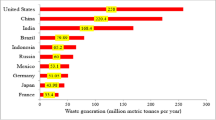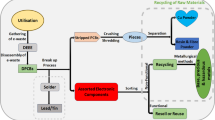Abstract
The End-of-life Vehicles Recycling Act went into effect on January 1, 2005, in Japan and requires the proper treatment of airbags, chlorofluorocarbons (CFCs), and automobile shredder residue (ASR). The need for optimal treatment and recycling of ASR, in particular, has been increasing year after year because ASR is regarded as being difficult to treat. Dioxin-related compounds, brominated flame retardants (BFRs), heavy metals, chlorine and organotin compounds are all present in high concentrations in ASR. The authors conducted ASR melting treatment tests using a 10-tons/day-scale direct melting system (DMS), which employs shaft-type gasification and melting technology. The results obtained showed that dioxin-related compounds and BFRs were decomposed by this melting treatment. The high-temperature reducing atmosphere in the melting furnace moved volatile heavy metals such as lead and zinc into the fly ash where they were distributed at a rate of more than 90% of the input amount. This treatment was also found to be effective in the decomposition of organotin, with a rate of decomposition higher than 99.996% of the input amount. Via the recovery of heavy metals concentrated in the fly ash, all the products discharged from this treatment system were utilized effectively for the complete realization of an ASR recycling system that requires no final disposal sites.
Similar content being viewed by others
References
Sakagawa T (2002) Outline of the Automobile Recycling Law (in Japanese). Waste Manag Res 13:183–192
Hosoda E (2001) Toward legislation for the proper waste treatment and recycling of ELVs — the present circumstances and the future perspective of ELV recycling (in Japanese). Waste Manag Res 12:292–302
Nourreddine M (2006) Recycling of auto shredder residue. J Hazard Mater 139:481–490
Kim K-H, Joung H-T, Nam H, Seo Y-C, Hong J-H, Yoo T-W, Lim B-S, Park J-H (2004) Management status of end-of-life vehicles and characteristics of automobile shredder residues in Korea. Waste Manag 24:533–540
Joung H-T, Seo Y-C, Kim K-H, Seo Y-C (2006) Effects of oxygen, catalyst and PVC on the formation of PCDDs, PCDFs and dioxin-like PCBs in pyrolysis products of automobile residues. Chemosphere 65:1481–1489
Onahama-Seiren (2005) ASR treatment in Onahama refinery (in Japanese). Kozan 58:58
Masuda K (2002) Our approaches to automobile recycling and future tasks (in Japanese). Waste Manag Res 13:200–209
Osada M, Takamiya K, Sakai S (2004) Bromine behavior and metal control in MSW direct melting system. In: Proceeding of the 3rd International Conference on Combustion, Incineration/Pyrolysis and Emission Control. Hangzhou China, pp 355–359
Vehlow J, Bergfeldt B, Jay K, Seifert H, Wanke T, Mark FE (2000) Thermal treatment of E+E plastic waste. Waste Manag Res 18:131–140
Watanabe I, Sakai S (2003) Environmental release and behavior of brominated flame retardants. Environ Int 29:665–682
Sakai S, Honda Y, Takatsuki H, Watanabe J, Aoki I, Nakamura K, Shiozaki K (2001) Polybrominated substances in waste electrical and electronic plastics and their behavior in incineration plants. Organohal Comp 52:35–38
Sakai S, Osada M, Miyazaki T (2004) High-temperature melting of waste brominated flame retardants and behaviors of organic brominated compounds. Book of abstracts for the BFR2004 workshop, Toronto, Canada
Sakai S, Hiraoka M (2000) Municipal solid waste incinerator residue recycling by thermal processes. Waste Manag 20:249–258
Sakai S (2002) High-temperature melting of municipal solid waste. In: Ludwig C, Hellweg S, Stucki S (eds) Municipal solid waste management, strategies and technologies for sustainable solutions. Springer, pp 241–256
Kawai Y, Taguchi A (2000) Pyrolysis gas melting system. In: Proceedings of the International Conference on Combustion, Incineration/Pyrolysis and Emission Control. Seoul, Korea, pp 127–137
Watanabe J, Matsudaira T, Nakamura S, Suzuki Y, Yoshida T, Sudo M, Yamakawa Y (2000) High-temperature gasifying and direct melting furnace for solid waste. In: Proceedings of the International Conference on Combustion, Incineration/Pyrolysis and Emission Control. Seoul, Korea, pp 93–100
Hosoda H, Ito T (2000) Development of fluidized-bed pyrolysis and melting system for municipal solid waste. In: Proceedings of the International Conference on Combustion, Incineration/Pyrolysis and Emission Control. Seoul, Korea, pp 269–278
Shibaike H, Tanaka H, Naito M, Nishida Y, Usui T (2005) Injection technology of combustible dust in a direct melting furnace for municipal solid waste (in Japanese). Tetsu-to-Hagane 91:457–464
Shinbaike H, Takamiya K, Hoshizawa Y, Kato Y, Tanaka H, Kotani K, Nishi T, Takada J (2005) Technical development for high performance in direct melting process for municipal solid waste (in Japanese). Nippon Steel Tech Rep 382:21–27
Sakai S, Watanabe J, Honda Y, Takatsuki H, Aoki I, Futamatsu M, Shiozaki K (2001) Combustion of brominated flame retardants and behavior of its byproducts. Chemosphere 42:519–531
Iwamura T, Kadokami K, Jin-Ya D, Tanada K (2000) Determination of organotin compounds in biological samples using ethyl derivatization and GC/MS (in Japanese). Bunseki Kagaku 49: 523–528
Japan Environmental Sanitation Center (2005) Technical report of the investigation on ASR recycling and effective use of slag (in Japanese). Japan Environmental Sanitation Center, Kawasaki, Japan
Osada S, Osada M, Kokado M, Tokuda M (2004) Thermodynamic study of the behavior of elements with low boiling points in the melting process (in Japanese). J Jpn Soc Waste Manag Experts 15:353–362
Kawamura Y, Maehara T, Suzuki T, Yamada T (2000) Determination of organotin compounds in kitchen utensils, food packages and toys by the gas chromatography/atomic emission detection method (in Japanese). Shokueishi 4:246–253
Fromme H, Mattulat A, Lahrz T, Ruden H (2005) Occurrence of organotin compounds in house dust in Berlin (Germany). Chemosphere 58:1377–1383
Author information
Authors and Affiliations
Corresponding author
Rights and permissions
About this article
Cite this article
Osada, M., Tanigaki, N., Takahashi, S. et al. Brominated flame retardants and heavy metals in automobile shredder residue (ASR) and their behavior in the melting process. J Mater Cycles Waste Manag 10, 93–101 (2008). https://doi.org/10.1007/s10163-007-0204-y
Received:
Accepted:
Published:
Issue Date:
DOI: https://doi.org/10.1007/s10163-007-0204-y




